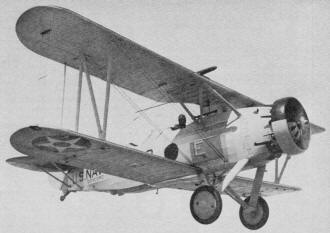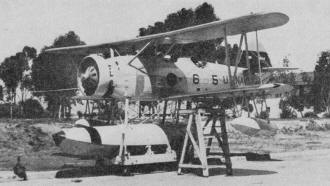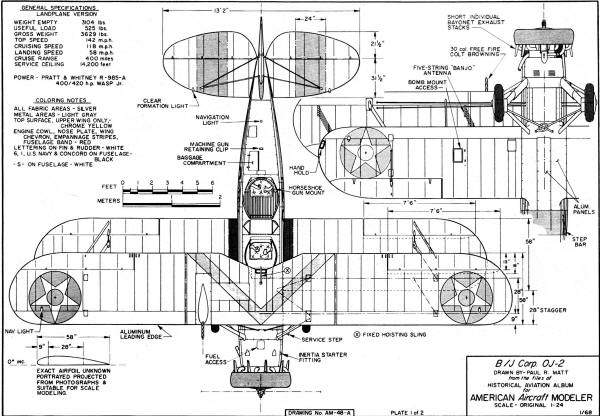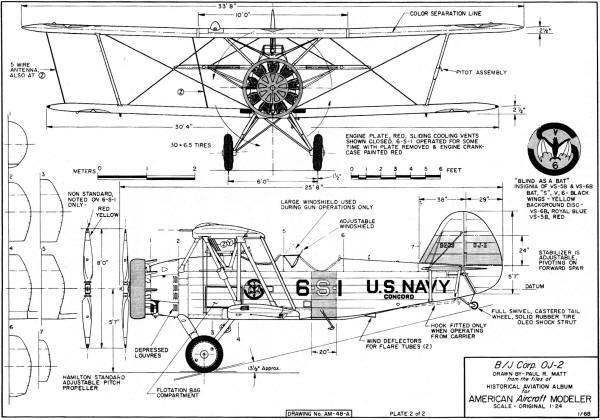|
The
Berliner-Joyce OJ-2 was a multi-purpose biplane built for naval
service. Its maiden flight was in 1931. As this American Aircraft Modeler
magazine article
photos show, it could be configured with wheels or floats. Berliner-Joyce Aircraft
Corporation had is main offices in Baltimore, Maryland, which was a popular location
for defense contractors then and now. The
Glen L. Martin Company, manufacturer of
the famous Martin B-10 Bomber, was also in Baltimore. The OJ-2 was in heavy
competition with the Vought O2U Corsair, which, unlike its eventual
and much more famous successor gull-wing, all-metal
F4U Corsair, was a fabric-covered biplane. Someone at Vaught
must have really been stuck on using the Corsair name - which was the name given
to Muslim pirates and their ships that operated off the
Barbary Coast. Author Paul Matt provides a fairly extensive
amount of historical information on the OJ-2, and the article includes a nice set
of 3-view line drawings.
The Berliner-Joyce OJ-2

Cruiser Division 3's OJ-2s fly formation. Each cruiser, USS Cincinnati,
Detroit and Milwaukee, had two VS-6B aircraft assigned from 1933 to '35. Tail stripes
are red on 6-S-7; nose cowl, fuselage band and wing chevron are black. Identification
was stressed.
Called the hard luck company, the B/J Corp. struck out three times with the Navy.
But the fourth time up, they scored a resounding success.
Paul R. Matt
There were a great many consolidations and mergers in the aircraft business during
the late 1920's and early '30's. Large financial interests became more aware of
the growing aviation industry. Where there is growth, there is prosperity, money
and profits. In some cases this entry of big business had an adverse effect, in
others it provided the needed financial backing for a struggling firm to succeed
where it might have failed because of the fast-changing times. One of these large
concerns was North American Aviation, Inc., which incorporated under the laws of
Delaware on Dec. 6, 1928 for the purpose of buying, selling and trading in securities
and stocks of aviation companies. One firm purchased was the original Berliner-Joyce
Corp.
The Berliner-Joyce Aircraft Corp., with main offices in the Hearst Power Bldg.,
Baltimore, Md., was incorporated in 1929 as the successor to the Berliner Aircraft
Corp. of Alexandria, Pa. President was W. W. Moss with Henry Berliner and Temple
N. Joyce as Vice-Presidents.

This is the second of the two OJ-2s of VS-6B from the four-stack
cruiser, USS Concord. Large letter "E" with the small "M" underneath was the symbol
for Excellence in Machine Gunnery.

Ashore for a check-up is this ex-VS-6, OJ-2. Operations of these
aircraft were equally divided between land and seaplane versions. Wide, red stripe
on main float is prop danger line.

Eighteen OJ-2s were specially built for the Naval Reserves. Based
at Anacostia, Naval Reserve Aviation Unit, Squadron 6, Aircraft One is symbolized
by the designation 6N1.
In 1930, during reorganization and the purchase of the major stock by the North
American holding company, Berliner left the firm. Henry Berliner, a pioneer in aviation,
first came into prominence in 1922 when he successfully demonstrated his "vertical
lift" aircraft to the U. S. Navy. This helicopter was surprisingly advanced in aerodynamics
and design but the world wasn't ready to accept any form of rotary-winged aircraft.
In. order to retain their identity the new company formed as the B/J Corp., retaining
the initials of the two founders. Temple Joyce remained with the new B/J Corp. and
became president late in 1930 when W. W. Moss resigned. He then remained in this
capacity until the firm was dissolved in 1934 and North American Aviation, Inc.
actively engaged in the development and manufacturing of aircraft.
Dozens of promising designs were proposed by the B/J firm. Only five actually
saw fruition. F. S. Hubbard was employed as Chief Engineer and W. H. Miller as his
assistant. Hubbard remained with the company for about a year, and Miller succeeded
him as Chief Engineer. Thus most of the B/J designs stem from the latter's ability.
Entering the highly technical and demanding field of military fighter aircraft,
B/J sought Navy contracts with the XFJ series, the XF2J and XF3J. All were rejected.
Only with the Army Air Corps' P-16 and the Navy observation OJ-2 were they successful
in obtaining a production contract.
In 1930 the U.S. Navy requested bids from the industry for a new, light-weight
observation aircraft to replace the heavier, Vought O2U Corsair. BuAer Design No.
86 stipulated a convertible land/seaplane of conventional design, suitable for use
on the new compressed-air-type catapults aboard light cruisers. Two companies gained
contracts for one experimental machine each. The Keystone Aircraft Corp. produced
the XOK-1 and the B/J Corp. the XOJ-1. Both machines employed the Wright 300-hp
R-975A engine and in general appearance were very similar since both followed the
BuAer design formula.
On January 1, 1931 the Keystone XOK-1 was turned over to the Navy at Anacostia
for evaluation. The XOJ-1 followed with-in the week. The XOK was a pot-bellied,
rather antiquated design that incorporated a forward trend by having a monocoque
fuselage. Appearance was deceiving because it outperformed its competitor during
initial trials.
The B/J XOJ-1 was of tubular metal construction throughout and fabric covered.
It featured full-span Zap flaps in both upper and lower wings. These operated both
as wing flaps for shorter landings and takeoffs and also independently as ailerons.
This feature had certain aerodynamic advantages but was apparently too involved
to justify itself.
Following initial trials at Anacostia and Dahlgren during January and February,
both machines were returned to the contractors with a number of suggestions and
modifications to be undertaken. When the aircraft were returned in April, the XOK
had a new 400-hp Wright R-975C engine and the XOJ a 400-hp P&W R-985A Wasp Jr.
Performances improved considerably and gross weights had been reduced nearly 100
lbs. The B/J abandoned the flaps and with other cleaning up showed a top speed of
over 153 mph compared to its previous 128.9 mph. The Keystone gradually fell behind
in the step-by-step process of evaluation, during the second round of tests.
Military contracts were slim during this time. U. S. Navy aviation fiscal appropriations
for 1931/32 were $31,145,000, a decrease of $888,211 from the previous year. Funds
were spent cautiously. The XOK and XOJ faced stiff odds. Decisions were carefully
considered. Finally, on October 26, 1931, the choice was made; Contract 24280 was
issued for 18 of the B/J machines to be designated OJ-2.
The Navy's decision was correct. The little known or remembered OJ-2 became an
extremely rugged and reliable aircraft, filling a number of valuable roles as late
as 1941. The OJ-2 grossed 3629 lbs. as a landplane version, a weight savings of
over 350 lbs. compared to the late Vought (02U-4) in a similar configuration. It
also got 151.3 mph out of its 400-420 hp engine while the Vought was doing 137.8
mph on 450 hp.
OJ-2s were assigned fleet duty and placed aboard the light cruisers in 1933.
Squadron VS-5B of Cruiser Division 2 was fully complemented by June of that year
and VS-6B was assigned to Cruiser Division 3 during the same period. The OJ-2s served
aboard the USS Cincinnati CL-6, Concord CL-10, Marblehead CL-12, Memphis CL-13 and
Trenton CL-11, to name a few. Normal complement of observation planes aboard a light
cruiser was two. B/Js served well on an active duty status between June 1932 and
late 1935 when the first Curtiss SOCs began to arrive.
The Curtiss machines officially replaced the B/Js on the June 1936 Fleet assignments.
Two OJ-2s remained aboard the USS Langley CV-1 well into 1936 as utility planes.
Operations were equally divided between the landplane and float equipped versions
during the four years of active duty in the Cruiser Divisions. During this same
period several OJ-2s also served with the USS Detroit as command aircraft, Battle
Force Commander of Destroyers. From 14 to 16 of the initial 18 planes built were
continuously assigned and on active duty at sea. Little trouble was encountered
during many flight hours either aboard ship or temporarily based ashore - a tribute
to a handful of rugged aircraft and proficient pilots.
Extra observation planes were needed as more ships of the Battle Force, Cruiser
Division were fitted with catapults. In 1933 nine more OJ-2s were ordered. Unfortunately,
the cruiser modifications took considerably more time to complete than the manufacture
of aircraft. Planes on this order were used for rotation and replacements. The picture
changed completely with the advent of the Curtiss SOCs. These aircraft, with their
folding wings, more easily met the new requirements that included use aboard all
line ships from light cruisers to battleships. Newer ships, including cruisers,
had provisions for storage of extra VSO type aircraft. Only the folding wing plane
could be accommodated and the B/Js had rigid wings.
The tenth production OJ-2, BuNo 9196, was kept at the Naval Aircraft Factory
and Anacostia during the early part of 1934 for possible improvements and refinements.
An enclosed sliding canopy was fitted over the cockpit, a long-chord NACA cowl fitted
over the engine and split trailing-edge wing flaps installed. As such, it was redesignated
XOJ-3.
In March 1934, during some tests, it was involved in an accident. But the trials
up to this time proved the modifications were not of sufficient value to warrant
their incorporation either as in-service changes or in future production. The XOJ-3
was rebuilt as a standard OJ-2 and turned over to the Naval Reserve at Seattle,
Wash. where it served until 1940. It retained its long-chord engine cowl and cockpit
canopy.
It was in 1934 that an additional 12 OJ-2s were procured. All were ordered exclusively
for service with the Naval Reserve. Between 1935, when the Reserve got their first
OJs, and 1938, the B/Js enjoyed their greatest years of popularity and publicity.
When the Curtiss SOCs replaced the older OJs for sea duty, all the B/Js, regardless
of status, were put on the inactive list and turned over to the Reserve. Because
of their easy flying qualities and stable flight characteristics, many were used
for instrument and blind flight training.
Since only 39 OJ-2s were built by 1937 and 33 were active with the Reserves with
one at Norfolk for repair, there remained but five aircraft unaccounted for. In
the fabric-covered days, a plane's useful military career seldom exceeded five peacetime
years. The OJ-2s had served several years longer than usual. Considering the many
and varied roles they played, this record speaks well for the design.
A long and exciting story cannot be written about the OJ-2s, since they served
in the seemingly unglamorous and often routine yet valuable role of observation
aircraft. To do a job well, a job that must be done, without fanfare and long pages
of exciting logbook notes is tribute enough. To be remembered once in awhile as
having been able to do your share is satisfaction honestly earned. The B/J s served
without much notoriety and proved the possibility of using the airplane aboard light
cruisers and operating in full cooperation with new fleet tactics. The OJ-2s were
not unique or unusual aircraft. Their place in history is one of being simply the
right airplane, at the right time to fill the right job.

3-View Drawing of the Berliner-Joyce
OJ-2 Biplane (page 1)

3-View Drawing of the Berliner-Joyce OJ-2 Biplane (page 2)
Posted October 19, 2019
|




